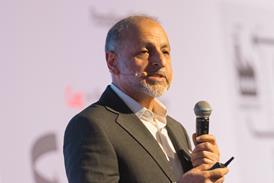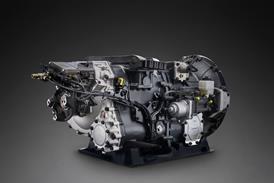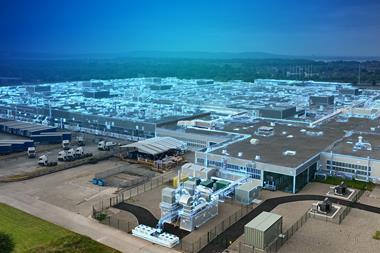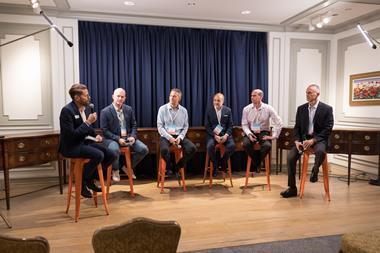
UK car production is a rare sight these days and it took a dramatic turn around in production processes to keep Bentley on British soil. AMS went to Crewe to talk to Senior Production Manager Dave Hudson about the Bentley Production System
Before Rover and Peugeot ended UK operations in 2005 and 2006 (at Longbridge and Ryton), analysts had long been predicting the end of British car production. The industry was falling victim to cheaper, more efficient global competition. When Rolls-Royce and Bentley were broken apart in 1999, purchased by BMW and Volkswagen respectively, it appeared that yet another pair of famous names were to be added to the register of ex-British carmakers. Yet both have managed to survive, indeed prosper, with Bentley’s success due in large part to a complete overhaul of the company’s manufacturing practices.
“When we lost Rolls-Royce, that was a real shock to the workforce,” says Dave Hudson, Senior Production Manager at Bentley. “People had a lot of doubts, about the loss of Rolls- Royce and being owned by a German company. Although Bentley was 90 per cent of the build and Rolls-Royce 10 per cent, when people were asked, ‘who do you work for?’, the answer was always ‘Royces’, so losing Rolls-Royce was like losing your identity.” It was not until Volkswagen put forward £1 billion of investment cash for the company that employees began to feel more confident in their collective future. “The investment was a signal of intent. With new product on the horizon, people started to connect, they realised this was serious; this was genuine,” says Hudson. The cash injection from Volkswagen also brought home the message that things had to change within the company itself. At that point, Bentley was producing between 800 and 1,000 cars per year, a figure that had to increase to improve the company’s overall viability. “We had a great management team at that point, people from a wide selection of backgrounds,” Hudson points out. “With people from Bentley, VW, some from BMW, Mini, Rover, Toyota and Honda, it was a good mix.”
 Building the Bentley Production System
Building the Bentley Production System
The first step on what essentially amounted to rebuilding Bentley was to investigate how others in the business had gone about improving their own production methodologies. “We visited Jaguar, Nippon Denso, Leyland DAF and quite a few others, to see how they had gone about their journey. From this, we developed what is known as the Bentley Production System (BPS).”
According to Hudson, the BPS is not limited to production. Instead, it is, as he puts it, “a holistic view on how to operate.” Working with Doug Dickson, current Member of the Board, Manufacturing, and Peter Nixon, current Production Director, Hudson pulled people from all different levels, managerial and shopfloor, to develop the system.
“That way of doing it was slower, because we had to give a lot more time to people in order to understand what they wanted,” says. ‘We could have written a set of guidelines and said, ‘there it is, do it like this’, but doing that you don’t get the changes in the organisation following the way people want to work. You also miss things, the different ways that people do their jobs.”

This initial development phase of the BPS took a year. “We knew the body (of the Continental) was going to be built in Germany, which was purely a matter of investment cost, VW already having the capacity. Instead, we focused on the core competencies already available here at Bentley: the engine, leather, interior execution. There wasn’t any pressure to ‘build this, build that’. What we did was build the foundation that you’d want for the future. That was critical, even at the expense of short-term wins. VW didn’t put forward a £1 billion investment for the short-term, they were in it for the long-term, and we had to be sure that we delivered a longterm strategy.” Development of the BPS wasn’t just based on theory, the Arnage line serving as a testing site for the layout of role model cells, allowing people to buy-off the way they wanted to work, building a standard platform that included ergonomic features.
“When we had developed the BPS, we laid out an area of the Arnage line called Chassis 1, complete with new lighting, new flow racks, all the process pitches, all the tooling, the Autotech-sourced control system with full lineside addresses. Then we asked the associates and board members, ‘is this better, does this feel right?’”
The Bentley Production System is constantly evolving, undergoing changes to suit shopfl oor colleagues’ working environment. A central part of this evolution is the dedicated Kaizen Centre, which includes the Continuous Improvement workshop. “An associate on the production line will have an idea, come in here and they can use magnets on whiteboards to mock-up the proposed redesign of the workstation, changing the layout and design of the fl ow racks, incorporating ideas like neutral picking points. All the dollies are made up here to our own specifi cation, to suit the process. The associates create their own designs and then the Kaizen team will build the fi nal versions; the Kaizen team are all shopfl oor workers,” explains Dave Hudson.
On Chassis 1, the fi rst section of the Continental production line, Hudson points out a product of the workshop. “The seat you see here (on the dolly) wasn’t there originally. What we used to do to get in the boot (to attach the multiple wiring harnesses) was crawl under the car and then put a seat on the track. Now, the seat is permanently attached, it goes with the car. Removing the seat took about four seconds, taking the seat to the next car and installing it was about another 10 to 15 seconds. It’s a really simple change, an easy idea, that has saved that time.” Before adding the second production line, each new development was trialled on the newly-condensed Arnage line. In addition to the hang-on system, new racks and dollies were added as they came out of the Kaizen centre. Says Hudson, “As we built the trial cars, you would start to see the process changes. Overall it took 12 months to see an appreciable difference on the Continental line, through the trial phases. The prep work paid immediate dividends, allowing us to reach the 7,000 units required in the launch year of the GT coupe. “There is a very deep logic in allowing people to understand they are in charge, they are responsible for their own process.
The shopfloor write their own standardized work charts, they write their own documents, do their own takt changes, so there’s total control. They do their own video reviews. We video the process and then we’ll sit and watch the videos to see where we can improve the process. Very few people do that. To begin with, people thought it was very intrusive. It took four to fi ve months to get that implemented, but that’s what it comes back to. I could have written the document and put it into place, but in line with the BPS, people have got to come with you on that journey, people have to feel a part of the journey. “Within group, we are now the lead player for continuous improvement thinking. Audi has been here to look at our process. That’s another thing that spurs us on, getting greater synergies with group, how to get recognition for all the work we’re doing.”
 New assembly line
New assembly line
Space was a major consideration for Bentley. Before the development of the BPS it was generally accepted that a second production line would require construction of a new building. “The current shop was only full because of the way of working,” Hudson explains. “Too much overflow, too much stock – there was no pull in the system, everything was push. So we focused all of our efforts on reducing the current layout to create space. Overall, we opened up 42 per cent of the workshop, allowing us to locate the new assembly line in the same building.
“Further, we used that exercise as a training activity. In essence, we self-generated our own Kaizen self-improvement team, made up of Bentley associates and one or two core experts, the latter trained in lean methodology. The way we did it was important too. Rather than doing it ‘at them’, we made the changes ‘with them’. For example, when it came to the stitching and sewing area, we didn’t go in and tell them how it was going to be done, we put somebody in there to allow us to take somebody out, to be involved with the layout, the way of doing it.”
Penny for your thoughts
When it came to streamlining shopfloor work processes, Bentley’s own associates proved to be a rich source of ideas. “In the first year, we received about 1,500 ideas from the shopfloor on how to improve things. That’s two to three ideas a day, at least two thirds of which were implemented. What was good about that was: one, the involvement; two, a demonstrated openness to change; and three, feeling part of the journey. People could see changes for themselves, feel part of the change, that it was happening with them.
“Generating ideas is part and parcel of the job, but we wanted ideas that the associates could implement themselves. Retooling is not an option, maybe that could be worked into the next-generation cars. But in the day-to-day, it’s what can I do better myself. The sorts of ideas we were getting included less walking, the way the part is presented, the tools, the working of the process. People can now make their own flow racks, make their own dollies. We have people coming in on Saturday morning overtime, changing the station layouts to improve efficiency. Very different from other companies, where (outside) people come in and do all the changes. Part of the BPS is how associates own their own processes, the flow racks, making it personal to your way of working.
 “There are four thousand people working here. If every person here saves five seconds, or a penny, or a euro, that can add up to a lot of money. We want everyone thinking, ‘how can I do my job better?’, and that’s quite different from handing over someone’s ideas for someone else to implement.”
“There are four thousand people working here. If every person here saves five seconds, or a penny, or a euro, that can add up to a lot of money. We want everyone thinking, ‘how can I do my job better?’, and that’s quite different from handing over someone’s ideas for someone else to implement.”
The leather used to trim and upholster each Bentley is passed through a rigorous grading procedure, carried out by both human and electronic eyes, both of which have to learn in their own way what parts of the hide can be used and where. “New associates attend the Bentley Training School for a full week before becoming production line trainees. Part of this is teaching associates how leather is made,” says Bentley’s Dave Hudson. “It’s not enough to say ‘here’s some leather, grade it,’ they need more background, know what is acceptable. “When we grade leather, it is fi rst marked up.
Green tape means you can use it, but only in certain areas of the car, and orange tape marks unacceptable areas. The remainder is perfect. We have a Gerber machine which, using an optical recognition camera, looks at the tape markings and other imperfections, and nests the required pattern and cuts the piece. The machine’s memory holds an image database of which natural markings are acceptable and which are not. “From cut, you move into sew. Broken into so-called sew boxes, a specific stitching is completed by the colleague, then pushed down the line for the next stitching. Each row of seamstresses makes a different article, for instance seats or cabin.” Delivery of the cotton for stitching the leather is the result of another piece of Kaizen work. Where previously, cotton reels were stored haphazardly, the reels are now stored in purpose-specific vertical racks, designed to colleague specification. As the racks run low on content, the end label is scanned, triggering a refill request.
Hudson continues: “Quilted leather seats take longer to make, but the standard seats take less time and, in that way, a balance is achieved in takt times. Buffers for the trim areas, headliners, parcel shelf, grab handle, sun visor, are quite small, there’s not a large amount of finished stock.”
Setting the pace
The ultimate goal of the BPS was to increase vehicle output to meet customer demand. “We didn’t hire (additional personnel) to increase volume. We ran the line quicker, reducing takt times. We knew at a point in time, volume needed to go up to meet demand. So if the takt time was 21 minutes, over four week periods, we’d reduce the takt times to 20.5, 20, 19 minutes. But we didn’t build 80 more cars. Instead, we had downtime, which the teams used to discuss how they could further reduce their own times. So the teams effectively generated their own time to develop time-saving ideas. As a result of this, times were further reduced, by 20 or 30 second increments, allowing even greater opportunity to generate time-saving ideas. Once these changes had been put into place and signed off by everyone in the shop, only then did we go to sales and marketing and say, ‘we can build you this many more cars per week’. Over two or three years, we saved about 30 per cent in takt times” But with the bespoke nature of the Bentley product, isn’t it difficult to measure and implement takt times?
“Take the steering wheel. You have one process 11 hours long – a takt time of 11 hours. In this case, we had special focus reviews to identify ways to reduce the processes times. On a moving line it’s easier, as you have smaller cycle times. If you went to a supplier, you ‘d see a seat or a dashboard turning up lineside just-in-time. I make all that here, so I am my own first-tier supplier, which helps, because it’s easy to balance the workload and you’re in control of your own quality.”
The Continental production line, which produces the GT, GTC and Spur, as well as the Speed derivatives, currently runs 16-minute takt times at each of the 56 stations, with each car taking 168 hours to build. This includes the engine/ chassis marriage station, where the front axle, engine, subframe, rear axle, propshafts and heat shields are kitted and delivered to the line via a dedicated Dürr transfer skillet. “It’s a Bentley engine,” states Hudson. “We receive the block and machined parts from Salzgitter, and after that it’s unique to Bentley. We do the whole engine assembly, the cold and hot tests using Cooper Tools equipment; everything is done in Crewe. It was great, because it was something the associates could see and feel, but we had to deliver on the investment. We had to equal, if not exceed, the efficiency and quality of our German counterparts.”
Pull and feed
Inventory is strictly controlled in each of the areas supplying the production line. “When I first got here, we used to have inventory everywhere. Our way of thinking now is not to have the inventory. You let the line pull and you feed into the line. It’s a learned discipline, which is the most difficult aspect from a management perspective.”
Each area that supplies the production line has developed different ways of managing inventory. The instrument panels and dashboard assembly area has a hanging rack, and once that rack is full, production of that element stops. Seating, too, has in-built inventory controls, explains Hudson.
“A seat starts off with a Hammerstein frame, an ECU and a wire harness. Once it is bagged (covered), there’s full electrical testing, a quality buyoff, then its into the buffer area. The buffer area is colour-coded, so we know we can measure available stock. On the floor, we have red, amber and green areas. If available seats are only in the red area, the colleague must immediately inform a senior manager, because that means the line will potentially stop. Amber is good, and green OK. Optimum quantity is between orange and green. Outside green is too many. If there is no space for further seats, production stops and colleagues can attend quality circles and other training. This area has a weighted average for takt times, accounting for both two- and a four-door vehicles.”
According to Hudson, one process that can’t be balanced is the hand stitching of seats and other interior trim items. “This option takes 37 hours per car, including such parts as seats, doors and grab handles. When we were doing two per week, we took the car to the end of the line and then fitted the seats, but now we’re producing about 12 every week we pre-build the trim before the car is loaded on the line. You have to do that, otherwise you risk sending the car through without any interior, which would destroy your ‘right-firsttime’ ethic. When all the trim is scanned, the car is loaded.”
“At Bentley, our factory is an extension of the showroom. The production lines have to look spotless, and this has to be the norm, this is what customers expect. That’s how Dr Franz-Josef Paefgen would explain it,” says Dave Hudson of Bentley Motors. As such, Dr Paefgen would have approved of the so called pitstops, areas positioned at strategic points along the production line that explain to visiting customers how and what is taking place at that point in the manufacturing process.
“Our customers don’t want to come and look around a standard car company. They want to be able to see the way the car’s built, they want to be able to touch, they want to be able to talk, to see how the product is loved. They want to see the uniqueness, the craftsmanship in what’s being done,” says Hudson.
Customer visits to the Bentley production line are actively encouraged. “In other car plants, the associates are working hard,” says Hudon. “It’s not robotic, but they work, it’s impersonal. But their customer base is different. I can’t imagine customers of larger companies wanting to go and see how their car is made. On the other hand, Bentley customers are spending anything from £115,000 to £500,000; they want to see it being made, that’s the part that makes the journey complete.”
Upon entering the facility, a small visitor annex serves to display a pictorial history of Bentley, before going on to tour the production line. On the line, pitstops include explanation of such activities as instrument panel kitting, the activities taking place with the Chassis 2 line.
“Bentley’s customers have changed,” continues Hudson. “Whereas many people perceive our customer base to be made up of older, wealthy people who rarely drive the car, this has changed. New Bentley customers are business owners, entrepreneurs, people who drive their own car every day. They want to know about their car and having this facility on the production line allows us to show them what we do.”
Quality for tomorrow
Despite the success of the BPS, the team is pushing for more. “We’ve been on the journey now about five or six years, and if I said to you, ‘where are we now on that journey’, we’re about 50 to 60 per cent of where we would like to be. We’ve still got a long way to go. But that’s honesty. We know we’re not all things to all people, and we’ve still got to further tune the BPS.”
When asked whether quality has suffered with the increase in production figures, Hudson points out that the company must continue to meet customer expectations. “We have to make sure that whatever we do meets customer aspirations. We are slightly different to the normal car company, a bit more niche, we can’t go alien to that market. We can’t use reduced takt times as an excuse for reduced quality. But so far, we have maintained the craftsmanship and skill while pushing for greater efficiencies. That said, you cannot allow complacency to set in; don’t think you’re the best, because you’re not. Don’t think that you can’t do better tomorrow, because you can.”


































